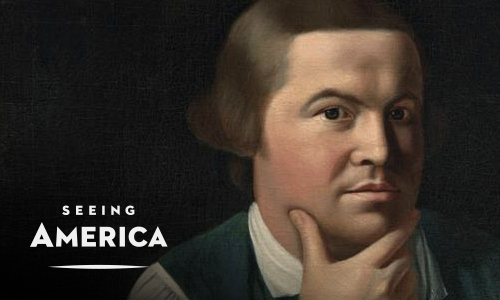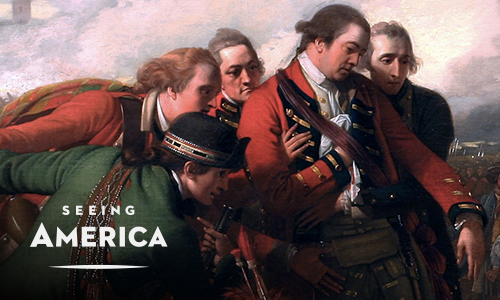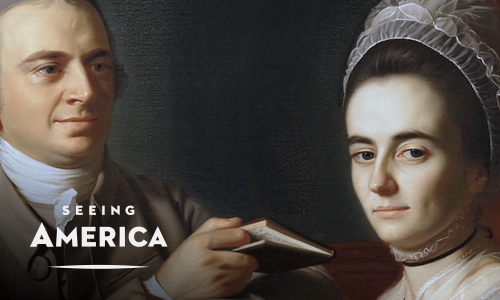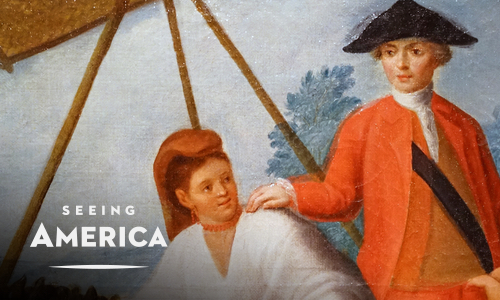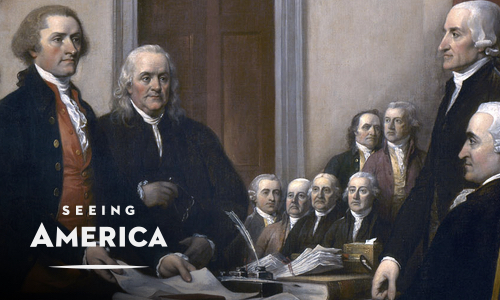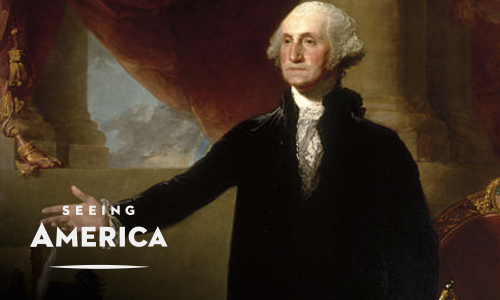“No taxation without representation!”
Essay by Dr. Bryan Zygmont
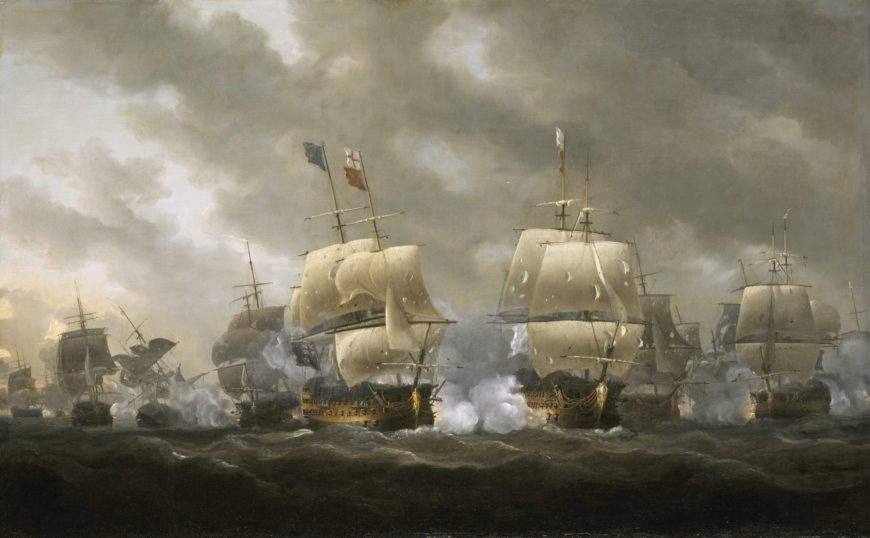
Nicholas Pocock, The Battle of Quiberon Bay, 20 November 1759, 1812, oil on canvas, 67.3 x 108 cm (Royal Museums Greenwich)
Great Britain wins and loses
In 1759 when the North American component of the French and Indian War (also known as the Seven Years’ War) concluded, Britain’s control of the continent was all but assured and the balance of power in North America officially rested with Great Britain. As a result, France relinquished its territorial holdings in Canada and all its possessions east of the Mississippi River to their great rival.
The year 1760 not only saw the de facto conclusion of the French and Indian War, it also saw the ascension of George III to the British throne. The Seven Years’ War—a conflict Britain waged in Europe, Asia, and North America—had emptied Britain’s coffers to such an extent that the country had borrowed—from private investors and banks—more than £150 million pounds to finance the war. To put this into current terms, this sum amounts to tens of trillions—yes, trillions!—of dollars today.
If you are King George III and you need to raise money — tax the colonies

Allan Ramsay and studio, King George III in Coronation Robes, c.1765, oil on canvas, 236.2 x 158.7 cm (Art Gallery of South Australia)
As a result, Britain had two herculean obstacles at the end of the Seven Years’ War. In addition to being practically bankrupt, the rolls of the British army and had swelled to a size far greater than was necessary in peacetime. That payroll, combined with the already existing debt, required an immediate influx of money.
There are only so many ways in which governments can raise money. The most common way to do so is in the levying of taxes, and in the decade following the conclusion of this conflict, Britain specifically taxed their colonial subjects to such an extent that it was one of the primary causes for the rally for independence from the mother country.
The Sugar Act of 1764 was a continuation of the recently expired Molasses Act of 1733, and although the tax per gallon of molasses—crucial to the creation of rum—was decreased by half, the enforcement of the tax collection was greatly increased. The Stamp Act of 1765 taxed almost any product with paper, including legal documents and contracts, newspapers, and even playing cards. The failure of the Stamp Act brought about the Townshend Acts (1767–78) in which the crown attempted to tax everything from paper and tea to paint and lead.
Intolerable Acts
The spark that may have ignited the powder keg for independence, however, was the 1773 Tea Act. Finally, “no taxation without representation!” — made famous by James Otis in 1765—became a rallying cry for those who wanted to formally break with Great Britain. The Tea Act was passed on 10 May.
The Boston Tea Party—more a political act of resistance and defiance than anything else—took place late in the evening of 16 December 1773, a little more than seven months later.
Soon after, the British Parliament passed the first of the so-called Intolerable Acts, which were intended to punish the colonists and assert British control. The Boston Port Act, for example, provided the British navy the authority to prohibit all ships from either entering or leaving Boston harbor. Another, the Quartering Act of 1774, gave the royally appointed governor the authority to house British soldiers in private citizens homes.
The colonialists viewed these Intolerable Acts as nothing short of punitive acts of war. The Battles of Concord and Lexington, fought between the colonies and Britain, commenced the American Revolutionary War less than a year later.
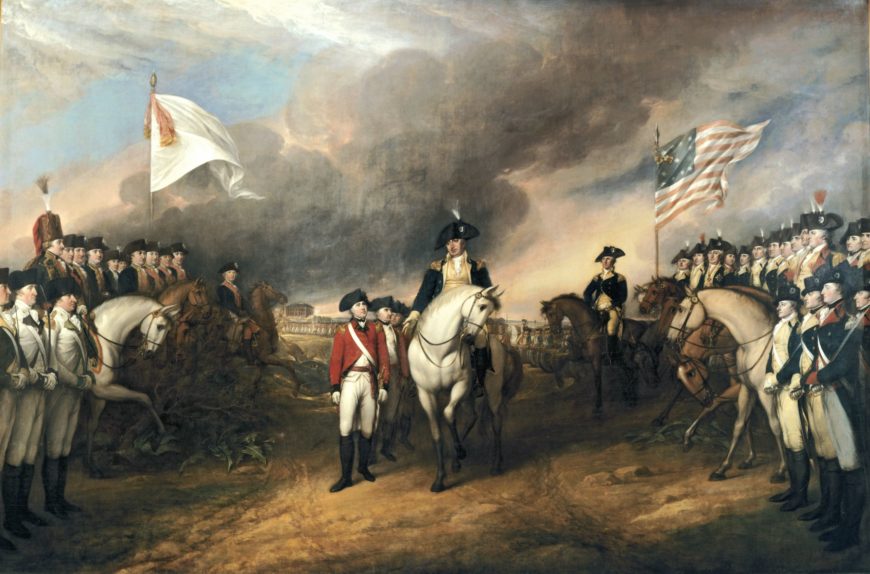
John Trumbull, Surrender of Lord Cornwallis, 1820, oil on canvas, 365.7 x 548.6 cm (Rotunda U.S. Capitol)
The next fifteen years—that is, from 1775 until 1790—were tumultuous times in North America. If the war began on 19 April, 1775 at Concord and Lexington, it was the surrender of Lord Cornwallis after the Battle of Yorktown (17 October, 1781) that brought the fighting to an end. British and American delegates signed the Treaty of Paris on 2 September 1783, and this formalized the American colonies’ break with Great Britain. Those fifteen years also witnessed the writing of two of the most famous legal documents in the history of the United States.
The Declaration of Independence
Indeed, the Declaration of Independence (“We hold these truths to be self-evident, that all men are created equal, that they are endowed, by their Creator, with certain unalienable Rights, that among these are Life, Liberty, and the pursuit of Happiness”) and the Constitution of the United States (“We the People of the United States, in Order to form a more perfect Union, establish Justice, insure domestic Tranquility, provide for the common defence, promote the general Welfare, and secure the Blessings of Liberty to ourselves and our Posterity…”) contain some of the most eloquent passages in regards to human governance that have been written.

John Trumbull, Declaration of Independence, 1819, oil on canvas, 366 x 549 cm (Rotunda U.S. Capitol)
But these two documents—the Declaration of Independence and the Constitution—had differing purposes. The first was to unite the colonial cause in opposition to tyranny, and the second was to create a working system of governance. Not surprisingly, the first of these—getting people to unite against despotism—is comparatively easier than the second.
The debates over the United States Constitution occupied large parts of the new nation from the moment it was presented in September 1787 until it was finally ratified by Rhode Island—the last of the 13 colonies—on 29 May, 1790. In the more than two and half years between those dates, something profound (yet not surprising) happened: two distinct groups—the Federalists and the Antifederalists—were formed because of vastly different views as to what the Constitution should be.
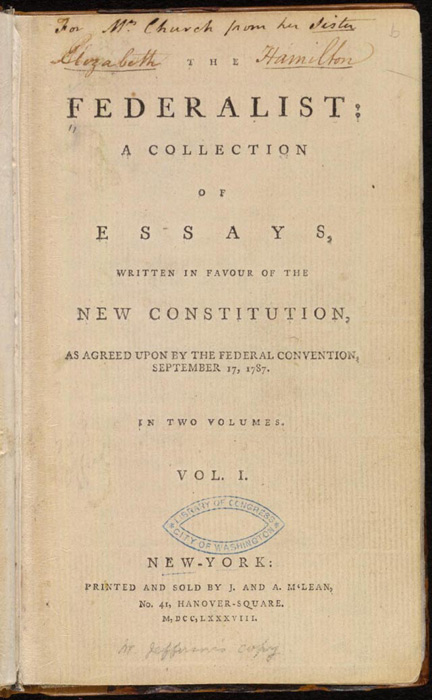
Title page of The Federalist: A Collection of Essays, Written in Favour of the New Constitution, as Agreed upon by the Federal Convention, September 17, 1787, Printed and sold by J. and A. McLean, New York, N.Y., 1788
The two-party system
This was the beginning of the two-party system in American politics. The Federalists—led by the writers of the Federalist Papers, Alexander Hamilton, John Jay, and James Madison—advocated for a strong centralized federal government, while the Antifederalists—Thomas Jefferson, Patrick Henry, and Samuel Adams among others—believed that the United States was best served by having stronger states’ rights and a less prominent federal government.
The fact that Hamilton, Jay, and Madison needed to write the 85 essays that comprise what is collected as the Federalist Papers suggests the discord and disagreement that existed in the newly formed country in regards to what the United States was to become. This discord, however, was to continue through the end of the century with the creation of the two-party system that is part of American politics to this day.
Even though the American electoral landscape was somewhat united under the (comparatively) apolitical George Washington through the end of his second term as president in 1797, the voting for his successor in the election of 1796 was hotly contested and acrimonious, even within the political parties themselves. John Adams, Washington’s vice president, defeated Thomas Jefferson by a relatively narrow electoral count of 71 to 68. This election was indicative of the political divide that would continue to this day.


